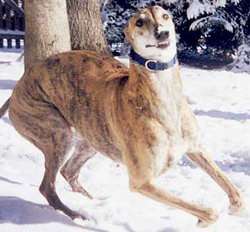Greyhounds and humans going round the bend

New research published this week has identified the fundamental differences between two and four legged animals that explain what limits their top speeds.
The research, published in the journals Nature and Biology Letters and funded by the Biotechnology and Biological Sciences Research Council, shows how a human running into a high-speed corner is forced to slow down and increase the amount of time their foot is in contact with the ground in order to withstand increased centripetal forces. Four legged animals do not appear to have this limitation.
The scientists at The Royal Veterinary College studied the results of 200m races at the 2004 Olympics and World Indoor Championships to demonstrate that the tighter bends used for the indoor event slow the runners down. To examine if this affects other animals they used high-speed video recording of greyhounds running time trials in an arena. Greyhounds barely change their stride when they sprint around and successfully withstand the increased forces. This is because they appear to power their running in a completely different way to humans.
Dr Jim Usherwood, the project leader, said, "Human sprinters use muscles to run that also have to deal with weight from the combination of centripetal and gravitational forces. Greyhounds get their motive power by torque around their hips and by extending their backs. This means that like a human on a bicycle there is a separation of the body structures providing power and the body structures supporting weight. A greyhound's top speed is not constrained by cornering forces in the same way a human sprinter's is."
Dr Alan Wilson, head of the Royal Veterinary College's Structure and Motion Laboratory, added, "Understanding the forces experienced by four-legged animals such as greyhounds and how their bodies deal with them means we can use them as a model to help improve the welfare of many animals. If we understand how animals work from a biomechanical perspective then we can understand how they suffer injuries and how they can best be cared for. The fundamental differences that we have shown between what limits running speed in four legged animals and in humans are important in understanding the mechanical limitations to performance and how different animals work.
Professor Julia Goodfellow, BBSRC Chief Executive, said, "Research such as this is important in helping us understand the biomechanics of humans and other animals. If we can gain an insight into how bodies actually move and work then we help to reduce injuries in humans and improve welfare for other animals."
Source: Biotechnology and Biological Sciences Research Council


















